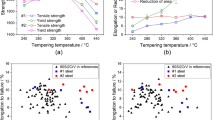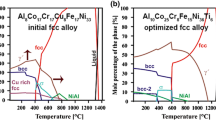Abstract
Ni-based model alloys with a base composition of Ni-20 mass pct Cr-3 mass pct Mo that were precipitation strengthened by the γ′ phase were studied in regards to their failure mechanisms as part of the fundamental research for achieving a creep rupture strength of 100 MPa at 1023 K (750 °C) and 105 hours. The microstructure, which was interrupted by transient creep, as well as the minimum creep rate and accelerated creep at 1123 K (850 °C) and 80 MPa was observed. The microstructure around the grain boundaries was altered remarkably with strain-induced grain boundary migration, while the γ′ particle size increased linearly inside the grains with increasing temperature and time. Furthermore, the volume fraction of the γ′ phase and the amount of precipitation on the grain boundary were associated with the size of the precipitate-free zone (PFZ), which is a major factor in creep damage. The appropriate precipitations inside the grains and at the grain boundaries were very effective for suppressing PFZ. Consequently, the creep properties can be improved by controlling PFZ in the proximity of grain boundaries for a superior balance of creep strength and ductility.









Similar content being viewed by others
References
M. Yonemura, T. Hamaguchi, H. Semba, and M. Igarashi: First Symposium for Project on Fundamental Studies on Technology for Enhanced Strength and Functions, New energy and industrial technology development organization. 2009, pp. 77–78.
M. Doi: Prog. Mater. Sci., 1996, vol. 40, pp. 79.
H. -A. Kuhn, H. Biermann, T. Ungár and H. Mughrabi: Acta metal. Mater, 1991, vol. 39, 2783-2794.
M. Enomoto and H. Harada: Metall. Trans. A, 1989, vol. 20A, pp. 649-664.
J. -C. Zhao, V. Ravkumar and A. M. Beltran: Meta. Mater. Trans., 2001, vol. 32A, pp. 1271-1282.
T. M. Pollock and A. S. Argon: Acta Metall. Mater., 1994, vol. 42, 1859-1874.
B. F. Dyson and T. B. Gibbons: Acta Metallurgica, 1987, vol. 35, pp. 2355-2369.
Y. Tsukada, Y. Murata, T. Koyama, N. Miura and Y. Kondo: Acta Materialia, 2011, vol. 59, pp. 6378-6386.
M. Yonemura, T. Hamaguchi, H. Semba, and M. Igarashi: 12th Inter. Conf. Creep and Fracture of Engineering Materials and Structures. 2012, pp. A45.
X. Xie, S. Zhao, and J. Dong: 5th Inter. Conf. Adv. in Materials Technology for Fossil Power Plants, Electric Power Research Institute. 2007, pp. 3A–6.
A. J. Ardell, R. B. Nicholson and J. D. Eshelby: Acta Metall., 1966, vol. 15, pp. 1295-1309.
J. Z. Zhua, T. Wanga, A. J. Ardellb, S. H. Zhoua, Z. K. Liua and L. Q. Chena: Acta Mater., 2004, vol. 52, pp. 2837–2845.
R. D. Doherty: Metal Science, 1982, vol. 16, pp. 1-14.
M. Dahlén and L. Winberg, Acta Metallurgia, 1980, vol. 28, pp. 41-50.
A. Porter, B. Ralph, J. Mat. Sci., 1981, vol. 16, pp. 707-713.
G. S. Was: Corrosion, 1990, vol. 46, pp. 319-330.
T. Ogura, S. Hirosawa and T. Sato: Materials Science Forum, 2007, vol. 561-565 pp. 235-238.
Y. L. Chiu and A. H. W. Ngan: Meta. Mater. Trans., 2000, vol. 31A, pp. 3179-3186.
L. Wang, G. Xie, J. Zhang and L. H. Lou, Scripta Materialia, 2006, vol. 55, pp. 457-460.
T. Terada, T. Matsuo, and M. Kikuchi: in Aspects of High Temperature Deformation and Fracture, Y. Hosoi, ed., The Japan Institute of Metals and Materials, 1993, p. 27.
M. Yonemura, T. Hamaguchi, H. Semba and M. Igarashi: CAMP-ISIJ, 2008, vol. 21, pp. 1349.
T. B. Gibbons and B. E. Hopkins: Metal Science Journal, 1971, vol. 5, pp. 233.
Acknowledgments
Some of the work in this study was conducted as a part of the research activities of the “Fundamental Studies on Technologies for Steel Materials with Enhanced Strength and Functions” by the Consortium of The Japan Research and Development Center for Metals (JRCM). We are also grateful for the financial support provided by New Energy and Industrial Technology Development Organization (NEDO).
Author information
Authors and Affiliations
Corresponding author
Additional information
Manuscript submitted June 29, 2015.
Rights and permissions
About this article
Cite this article
Yonemura, M., Semba, H. & Igarashi, M. Development of Microstructural Damage in Ni-Based Alloys During Creep. Metall Mater Trans A 47, 1898–1905 (2016). https://doi.org/10.1007/s11661-016-3346-5
Published:
Issue Date:
DOI: https://doi.org/10.1007/s11661-016-3346-5




